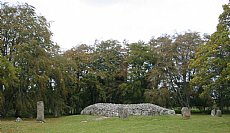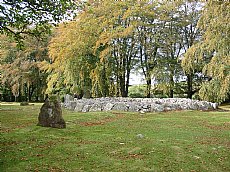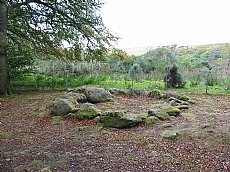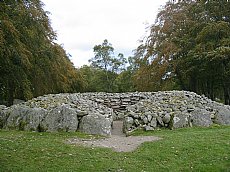Balnuaran of Clava cairns
01 February 2021
- News Type:
- Site of the Month
 The Clava Cairns have been the centre of attention for over a hundred years. They are part of a distinct regional burial tradition from west Moray to Glenurquart, and the upper Spey valley to the Black Isle. Two types of burial cairns, one with a passage to a central chamber, the other a closed ring cairn, are surrounded by a stone circle of monoliths. An interesting aspect of construction is that the stones in the inner and outer kerbs as well as the free standing circle are graded in heights, so that the northeastern members are smallest, the southwestern tallest. Most of the cairns with passages are also aligned to southwest, positioned to correspond with the setting of the midwinter solstice. Many of the stones have cup mark decoration.
The Clava Cairns have been the centre of attention for over a hundred years. They are part of a distinct regional burial tradition from west Moray to Glenurquart, and the upper Spey valley to the Black Isle. Two types of burial cairns, one with a passage to a central chamber, the other a closed ring cairn, are surrounded by a stone circle of monoliths. An interesting aspect of construction is that the stones in the inner and outer kerbs as well as the free standing circle are graded in heights, so that the northeastern members are smallest, the southwestern tallest. Most of the cairns with passages are also aligned to southwest, positioned to correspond with the setting of the midwinter solstice. Many of the stones have cup mark decoration.
 In the 1990s Richard Bradley and a team undertook detailed analysis of the cairns at Balnuaran of Clava (which gives its name to the monument type; MHG3013, MHG3002; MHG4366), as well as looking in depth at several others nearby. Fieldwalking in the area, particularly the areas between Culloden and Nairn, was also undertaken to provide further information about the prehistoric landscape in the area.
In the 1990s Richard Bradley and a team undertook detailed analysis of the cairns at Balnuaran of Clava (which gives its name to the monument type; MHG3013, MHG3002; MHG4366), as well as looking in depth at several others nearby. Fieldwalking in the area, particularly the areas between Culloden and Nairn, was also undertaken to provide further information about the prehistoric landscape in the area.
Before Professor Bradley’s work, these monuments were generally considered to be Neolithic, based on their superficial similarity to Neolithic chambered cairns. However, his work conclusively showed that these monuments are Early Bronze Age, a local tradition fusing that of Neolithic chambered cairns and the recumbent stone circle tradition further to the east, but built in different ways. The harking back to earlier burial traditions can also be seen in the large number of Neolithic chambered cairns which were re-used in the Bronze Age (and it is noteworthy that Neolithic chambered cairns are virtually absent in the area of Clava-type cairns). Moreover, at some of the Clava-type cairns the sites were re-used in the Late Bronze Age, showing further continuity of tradition. A small kerb cairn (MHG3012) was also built during the Bronze Age near to the central ring cairn.
Neolithic chambered cairns which were re-used in the Bronze Age (and it is noteworthy that Neolithic chambered cairns are virtually absent in the area of Clava-type cairns). Moreover, at some of the Clava-type cairns the sites were re-used in the Late Bronze Age, showing further continuity of tradition. A small kerb cairn (MHG3012) was also built during the Bronze Age near to the central ring cairn.
Bradley argues that the cairns need not be one period construction, perhaps with the circles and platforms coming later (Bradley 2016a, 116). Most are in low-lying areas, and he argues that they were probably near domestic settlements, supported by the fieldwalking evidence.
 The team took several years examining the monuments, and feel that their results are the better for it – as Professor Bradley put it, ‘taking time to become acquainted’ (Bradley 2000, 214). This also allowed them to see the monument in different lights, and from this he argues that stones were carefully chosen by shape and colour as well as height.
The team took several years examining the monuments, and feel that their results are the better for it – as Professor Bradley put it, ‘taking time to become acquainted’ (Bradley 2000, 214). This also allowed them to see the monument in different lights, and from this he argues that stones were carefully chosen by shape and colour as well as height.
The cairns still have an atmosphere, and attract modern attention. During the University of Reading fieldwork seasons, at the beginning of each year offerings were found, including coins (old and new), small amounts of cremated bone and small gemstones, all carefully deposited (Bradley 2000, 231-232). (As a scheduled monument, such activities are banned and should not have occurred). However, they show that the Clava Cairns have a significance to modern as well as Bronze Age people.
The work and analysis were also well served by the final publication (Bradley 2000), which provides details of the work as well as a number of thought-provoking insights. Why was this monument type built here in the Early Bronze Age, and what is happening elsewhere in the Highlands? Altogether Bradley’s study is a model for good practice on investigating research questions, using non-destructive analysis, integrating dating, having a landscape analysis, and providing a good publication.
Further information
Bradley, Richard 2000 The Good Stones. A new investigation of the Clava Cairns, Society of Antiquaries of Scotland: Edinburgh.
Bradley, Richard 2016 ‘After the great stone circles’, in Bradley, R and Nimura, C (eds) , The Use and Reuse of Stone Circles. Fieldwork at five Scottish monuments and its implications, Oxbow Books: Oxford, 112-121.
Highland HER MHG3013, MHG3002; MHG4366, MHG3012
Historic Scotland visitor guide
Site of the Month Archive
- 10/04/2021 Easter Raitts township
- 02/03/2021 Lower Slackbuie, Inverness (ASDA) Neolithic site
- 01/02/2021 Balnuaran of Clava cairns
- 04/01/2021 Wilkhouse Inn
- 02/12/2020 Spinningdale Cotton Mill
- 02/11/2020 Skibo A Canadian Forestry Camp
- 01/10/2020 WWI Detonator Store, Dalmore near Invergordon
- 03/09/2020 Mesolithic Shell Midden at Sand, Wester Ross
- 08/08/2020 Kinbeachie Neolithic settlement
- 01/07/2020 Armadale Cist Burial and Stone & Timber Complex
